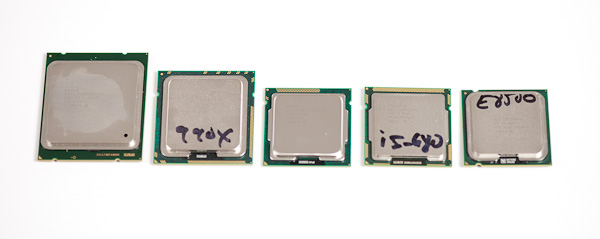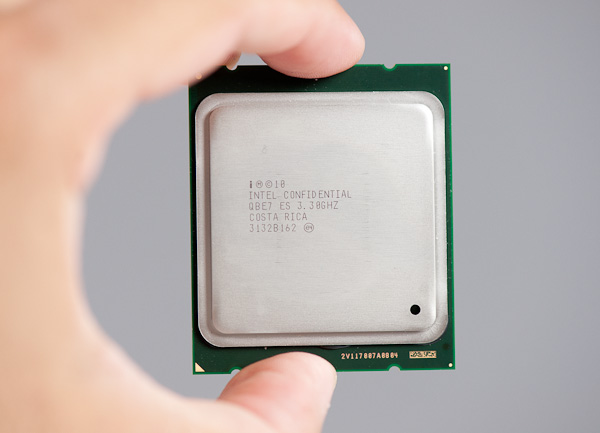Intel Core i7 3960X (Sandy Bridge E) Review: Keeping the High End Alive
by Anand Lal Shimpi on November 14, 2011 3:01 AM EST- Posted in
- CPUs
- Intel
- Core i7
- Sandy Bridge
- Sandy Bridge E
Final Words
There are two aspects of today's launch that bother me: the lack of Quick Sync and the chipset. The former is easy to understand. Sandy Bridge E is supposed to be a no-compromise, ultra high-end desktop solution. The lack of an on-die GPU with Quick Sync support means you have to inherently compromise in adopting the platform. I'm not sure what sort of a solution Intel could've come to (I wouldn't want to give up a pair of cores for a GPU+QuickSync) but I don't like performance/functionality tradeoffs with this class of product. Secondly, while I'm not a SAS user, I would've at least appreciated some more 6Gbps SATA ports on the chipset. Native USB 3.0 support would've been nice as well. Instead what we got was effectively a 6-series chipset with a new name. As Intel's flagship chipset, the X79 falls short.

From left to right: Intel Core i7 (SNB-E), Core i7 (Gulftown), Core i5 (SNB), Core i5 (Clarkdale), Core 2 Duo
LGA-2011, 1366, 1155, 1156, 775
The vast majority of desktop users, even enthusiast-class users, will likely have no need for Sandy Bridge E. The Core i7 3960X may be the world's fastest desktop CPU, but it really requires a heavily threaded workload to prove it. What the 3960X doesn't do is make your gaming experience any better or speed up the majority of desktop applications. The 3960X won't be any slower than the fastest Sandy Bridge CPUs, but it won't be tremendously faster either. The desktop market is clearly well served by Intel's LGA-1155 platform (and its lineage); LGA-2011 is simply a platform for users who need a true powerhouse.
There are no surprises there, we came to the same conclusion when we reviewed Intel's first 6-core CPU last year. If you do happen to have a heavily threaded workload that needs the absolute best performance, the Core i7 3960X can deliver. In our most thread heavy tests the 3960X had no problems outpacing the Core i7 2600K by over 50%. If your livelihood depends on it, the 3960X is worth its entry fee. I suspect for those same workloads, the 3930K will be a good balance of price/performance despite having a smaller L3 cache. I'm not terribly interested in next year's Core i7 3820. Its point is obviously for those users who need the memory bandwidth or PCIe lanes of SNB-E, but don't need more than four cores. I would've liked to have seen a value 6-core offering instead, but I guess with a 435mm2 die size it's a tough sell for Intel management.
Of course compute isn't the only advantage of the Sandy Bridge E platform. With eight DIMM slots on most high end LGA-2011 motherboards you'll be able to throw tons of memory at your system if you need it without having to shop for workstation motherboards with fewer frills.
As for the future of the platform, Intel has already begun talking about Ivy Bridge E. If it follows the pattern set for Ivy Bridge on LGA-1155, IVB-E should be a drop in replacement for LGA-2011 motherboards. The biggest issue there is timing. Ivy will arrive for the mainstream LGA-1155 platforms around the middle of 2012. At earliest, I don't know that we'd see it for LGA-2011 until the end of next year, or perhaps even early 2013 given the late launch of SNB-E. This seems to be the long-term downside to these ultra high-end desktop platforms these days: you end up on a delayed release cadence for each tick/tock on the roadmap. If you've always got to have the latest and greatest, this may prove to be frustrating. Based on what we know of Ivy Bridge however, I suspect that if you're using all six of these cores in SNB-E that you'll wish you had IVB-E sooner, but won't be tempted away from the platform by a quad-core Ivy Bridge on LGA-1155.
I do worry about the long term viability of the ultra high-end desktop platform. As we showed here, some of the gains in threaded apps exceed 50% over a standard Sandy Bridge. That's tangible performance to those who can use it. With the growth in cloud computing it's clear there's demand for these types of chips in servers. I just hope Intel continues to offer a version for desktop users as well.











163 Comments
View All Comments
Hauk - Monday, November 14, 2011 - link
Was hoping to get 40 PCI-E lanes & 2600K performance for $300.. craptastic that they delay the 3820 till next year. Can't wait any longer, 2600K it is..medi01 - Monday, November 14, 2011 - link
Hi,why don't we see AMD cpu pricing along Intel CPU pricing?
g00ey - Monday, November 14, 2011 - link
I think it is false advertising to call the Bulldozer 8C an eight core CPU. It doesn't really have eight cores, it's actually only four cores where they have added an extra ALU inside each core. It's like doubling the core count of the i7s because of the hyperthreading (SMT) feature. The addition of ALUs is nothing but an enhanced version of hyperthreading so a Bulldozer 8C is only 4 cores, 6C is only 3 cores and 4C is only 2 cores.But AMD say; No No No, there are two computation CORES inside each MODULE.
What a BIG WAD of *BULLSHIT*!!!!!!!!!!!!!!!!!!!!!!!!!!!!
They should be thrown into jail for such fraudulent statements!!!
raddude9 - Monday, November 14, 2011 - link
Nope Mr. Troll.Bulldozer 8C can run 8 threads simultaneously. Sandy Bridge E with it's 6 multi-threaded cores can only run 6 threads at the same time, the other 6 threads have to wait.
BSMonitor - Monday, November 14, 2011 - link
Actually you are completely wrong.Hyperthreading actually allows 12 threads to fully utilize the resources of a 6 core processor.
Whereby, Bulldozer simply has double the Integer hardware. Allowing it to run 8 integer threads simulateously. So long as there are that many consecutive integer computations in a row on each thread. Beware when floating point threads start to appear. And then it crawls back to 4 cores.
raddude9 - Monday, November 14, 2011 - link
What did I say that is wrong?Hyperthreading means that each core holds the state of 2 threads. Only one thread can run at a time, usually when one thread stalls, the other thread can kick in. So, at best it can run 6 threads at once, the 6 hyperthreaded threads are waiting in the backround for their chance. But it still just runs 6 threads at once.
You are trying to mislead people with your mis-information on the Bulldozer Floating Point unit. It's FPU can run as either two independent 128bit FPUs or a single 256bit FPU. So it can run two independent Floating Point instructions at once. So, Regardless of whether Bulldozer is running Floating Point or Integer instructions, it can still run 8 threads at once.
LittleMic - Tuesday, November 15, 2011 - link
You are wrong because you are describing T1000 and T2000 CPU and not Intel with HT. Sun processor are indeed hiding memory access latency this way.Intel processors are actually scheduling micro instruction from both threads according to execution resources availabitity. It is quite old technology now so the white papers have disappeared from Intel web site, but if you have a look at
http://en.wikipedia.org/wiki/Hyper-threading
the picture on the right clearly shows that a pipeline stage can contain µ instructions coming from 2 threads
LittleMic - Tuesday, November 15, 2011 - link
No edit...Finally found "official" paper directly from Intel :
http://download.intel.com/technology/itj/2002/volu...
Have a look at page 10 that shows that all the pipeline contains instructions from both threads simultanously.
Lord 666 - Monday, November 14, 2011 - link
Anand,Have read mixed information on the release date for the 26xx series Xeons with respect to release date and architecture. Actually holding off a much needed server because have read either December or Jan.
With the socket the same, is the reviewed SB-E the same design as the new Xeons? Will there be 3D design like Ivy Bridge?
Thanks - Loyal reader for over 7 years
mwarner1 - Monday, November 14, 2011 - link
I am impressed by how much memory you had in your 386SX! My first (IBM compatible) PC was a 486DX2-50 I bought for my Software Engineering degree and it only had 4MB. This was pretty much standard for the time.